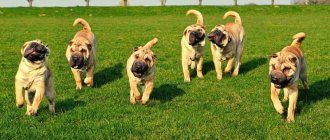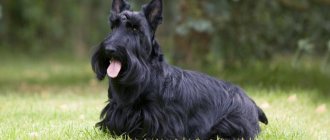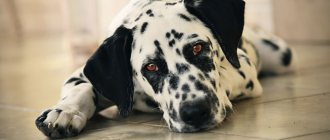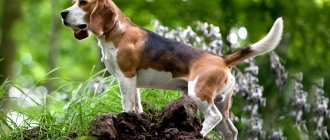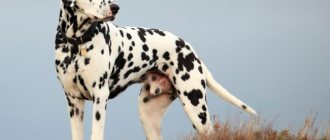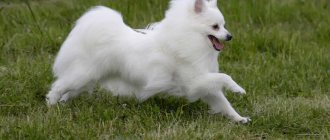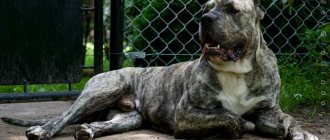History of the origin of the Shar Pei
There is an opinion that the Shar Pei first appeared in China, but this is just a hypothesis. Marco Polo, who lived in China for several years, described the Chow Chow and the Pug in 1271, but never mentioned the Shar Pei.
The most likely version of the origin of this dog breed dates back to 1751, when the Emperor of China initiated maritime trade. At that time, a popular game among English sailors was dog fighting. The British used bulldogs and mastiffs. The Chinese, not to be outdone, mixed their Chow Chows with English breeds to create a fighting dog. Despite this, the new breed still could not compete with the strong bulldogs.
Shar Peis were also widely used as hunting dogs. Hunting was a popular game among the nobility; they even started entire packs of Shar Peis, who were distinguished by their strength and intelligence.
In the 1940s, Mao Zedong called this cute breed “a symbol of the uselessness of the privileged class,” and terrible times came for Shar Peis - they began to be exterminated en masse, and exorbitant taxes were imposed on wealthy owners of purebred dogs. This led to the breed being almost completely destroyed. In 1950, only a few Shar Pei litters remained in Taiwan. Shar Peis were practically exterminated. Fighting dogs are preserved only in the capital.
After 15 years, the world recognized the Shar Pei with the nickname “Lucky”. He was born thanks to S.M. Chen. Then the dog was bought by the American breeder Herman Smith and Lucky became a pioneer - an immigrant to the United States. Another breeder, Matgo Low, saw an article in Dogs magazine about endangered breeds with a picture of a Shar Pei and the inscription “The last surviving representative of the breed”, asked all four-legged lovers to save these dogs from extinction.
From 1970 to 1975 enterprising people looked for dogs and restored the breed. Thanks to them, these dogs were able to spread throughout the world and delight us with kind smiles, soft faces and huge blue tongues.
How much should a 2 month old Shar Pei puppy weigh?
German Shepherd puppy weight at 2 months
For the full development of a dog, it is very important to monitor its nutrition. A dog's weight is a direct indicator of its health. Proper balanced nutrition at an early age contributes to the proper development of the puppy.
Development of a German Shepherd puppy.
German Shepherd puppies take a long time to develop. An animal that reaches three years of age becomes fully formed and mature. Until this time, the puppies grow and change their appearance somewhat. All of them at an early stage of development are practically no different. In general, puppies are proportionally built and reach small sizes.
Having reached the age of two months, puppies begin to develop their individual character and temperament. Then the animals begin to grow at a rapid pace. This is especially noticeable in the increase in the size of the paws, ears and tail.
The main feature of the German Shepherd is its somewhat disproportionate growth. For example, at the age of two months, the dog’s paws and tail become significantly longer. This difference becomes less noticeable by 4-5 months.
A weight of 6 to 9 kg is considered normal, as this is a large dog breed. But the spread between the weight of different pets can be quite large, since each animal has its own parameters. Everything directly depends on genetics and personal characteristics.
Because of this, the puppy begins to recognize the world around him from the house in which he lives. Be prepared for the fact that your German Shepherd puppy loves to play pranks.
In general, puppies of this breed develop quite rapidly. In the first months of life, they should gain weight at least 5 kg monthly. With proper growth and a sufficient amount of incoming minerals, right before your eyes, a small awkward puppy can turn into a large dog. But until the age of three, he will still remain a puppy.
Source
Description of the breed
Never underestimate this breed! At first glance, it may seem that Shar Peis are soft plush toys, unpretentious and gentle.
Few people know that Shar Peis were originally bred as hunting, guard and fighting dogs. This gave the breed a stubborn character and leadership position, quick reaction, intelligence and loyalty.
Definitely, Shar Peis are suitable primarily for experienced owners, people with a strong character and free time. Without early socialization and training, a Shar Pei can become aggressive and disobedient. With good training, the Shar Pei will be friendly, calm and affectionate. What your Shar Pei will be like is up to you.
Breed standard: main characteristics of Shar Pei.
Shar Peis have a recognizable “hippopotamus” face and a compact but strong body. They have average height, folds on the head and withers, small ears and a lot of charm.
Although when we think of a Shar Pei, we first of all think of a large number of folds, according to the breed standard, multiple folds on the body are undesirable. Acceptable places for folds are the cheeks, forehead, withers and base of the tail with moderate folding.
The tail is usually set very high and can take any position, but its absence is unacceptable. Of course, these rules apply only to show dogs.
The Shar Pei's coat is usually short and stiff, looking like bristles from one to two and a half centimeters. The coat color can be any color except white. Only the tail and hips can be lighter than the whole body, and the muzzle, on the contrary, is darker.
Size
Height from withers to ground - from 44 to 51 cm. Males are usually larger than females.
Shar Pei weight is from 18 to 35 kg.
Shar-Peis are a little boxy and slightly awkward in appearance, but their gait is always well-balanced.
Lifespan
Unfortunately, Shar Peis have a short lifespan of 10 years. In order for your dog to be happy and please you for a long time, you need to properly care for him and train him.
Intelligence
Shar Peis are excellent guards; their natural high intelligence and distrust allow them to accurately determine the intentions of a stranger. At the same time, he will not bark in vain and treats children well.
Despite the fact that this breed of dog is a fighting type, they will never be the first to get into a fight unless absolutely necessary.
Description and breed standard
Before getting a dog like a Shar Pei, the characteristics of the breed must be studied. Otherwise, you may later seriously regret your poor choice of pet.
Dimensions and weight
If you tell us what a Shar Pei looks like, first of all, you should understand the dimensions. Males and females are almost the same in height. On average, this figure is 46-51 cm.
But in terms of weight, the difference is quite significant - males are stockier and more powerful, due to which they weigh 25-30 kg. Bitches are noticeably lighter - about 18-25 kg.
Wonderful chubby
Varieties
As mentioned above, in the mid-twentieth century the breed was almost completely destroyed; only a few specimens were saved. They were taken to different countries of the world, where they painstakingly worked to restore the population.
Because of this, several varieties appeared, although they retained common characteristics, but differed markedly in a number of parameters:
- The American Shar Pei is taller than its Chinese ancestor due to its longer legs. The withers are more pronounced, and the body is lean. In addition, there are noticeably fewer folds on the body. The eyes are strongly pronounced against the background of the rest of the muzzle, and the nose has become a little smaller.
- The European (aka English) Shar Pei is slightly different in appearance, it has only become more rounded, even thicker. But his character has changed significantly - the dog is more phlegmatic and calm. He is very good as a companion dog, but his watchdog and security skills are seriously affected.
- The Bear Shar Pei gets its name from its bear-like appearance. The fact is that when restoring the breed, Chow Chows were used, which is why the dogs received softer, longer and shaggy hair than the Chinese Shar Pei. But bears are not allowed to compete, since they are not purebred representatives of the breed.
Coat type, colors
Finally, if you give a Shar Pei a description of the breed, you cannot miss such important characteristics as the type of coat and color.
Long-haired individuals are definitely a waste (bears are usually included here). Therefore, smooth-haired are the only acceptable option. The coat is hard, bristly and short, lacking undercoat and sticks out all over the body. Only on the limbs does it adhere to the body.
The number of colors is quite large. The following are considered norms:
- black,
- sable,
- deer,
- cream,
- red,
- chocolate,
- apricot.
However, depending on the club, standards may vary slightly. But in any case, the black or fawn sharpei will be recognized as the standard representative of the breed.
Color may vary
Shar Pei character
Shar Peis have a personality that matches their appearance. These are strong, good-natured dogs who, if necessary, can both protect their owner and play with him.
- Good disposition . Here you need to remember that sharpeis, if not properly raised, can show aggression due to their origin and independent nature, so it is necessary to teach the dog good manners from an early age. In order for these dogs to be patient with children and other animals, they must be raised properly. The Shar Pei can also get along with other four-legged members of the household, be it a cat or another dog, if they were raised together.
- Attachment to the owner . Shar Peis are very attached to their owner, but this love must be earned. You should be confident, feel like the king of the situation and be the leader in your relationship with this breed. Otherwise, the Shar Pei will not obey you, and you will lose control, and your pet as well.
- Cleanliness. The cleanliness of Shar Peis is legendary. In front of a puddle, a Shar Pei will definitely stop and look at its owner: “Either go around, or go home.”
- Communication skills. Shar Pei easily make contact with early socialization.
- Energy. Dogs of this breed are very active and need frequent walks and games.
- Sharp vision. Despite the many folds on their faces, Shar Peis are very curious and notice a lot. Thanks to their good attention and keen eyesight, they can be excellent guards.
Shar Pei training and education
Training a Shar Pei is an integral part of a dog’s growing up and upbringing. If you don't want the dog:
- showed aggression towards passers-by;
- barked at dogs and children;
- picked up food from the floor;
- walked you, not you him;
- spoiled your things;
- did not respond to his name and did any uncontrollable things, then training a Shar Pei needs to be taken more than seriously!
Shar Peis learn very quickly, and if you have the patience to repeat the same exercises over and over again, the results will not be long in coming. Already at three to four months you can begin a general course of dog training.
Training a Shar Pei is not much different from training other breeds. The main thing here is to follow the general rules and do everything in moderation.
The main thing to remember:
- Proper puppy training will avoid many problems in the future. The rule “Hard to learn, easy to fight” applies here.
- Shar Peis enjoy training because they feel important and needed, and are always looking forward to their next lesson.
- Your Shar Pei will not love you less from daily training; on the contrary, you will develop close contact with your pet.
- If the dog does something wrong, then most likely you are doing something wrong. Never accuse her of lack of understanding, do not scold her, and do not beat her under any circumstances.
All dogs have a general set of training rules. When training with a Shar Pei, in addition to these rules, you need to remember the character of the individual breed and take into account the disposition of your dog.
Height and weight of the puppy.
Tell me, are there approximate figures for Labradors in terms of height and weight? We weigh 14 kg at 5 months, next to us there is also a Labrador girl - at 3.5 she weighs 14800 kg. We're small, right?
Note: All these measurements are fairly approximate. Some dogs stop growing at 6 months, while others take up to a year to grow. Males are generally larger than females.
How to determine what is light? He eats great! Morning and evening drying - 200 gr. at a time, and for lunch I have a full cup of rice with beef + I give vitamins for bones and fish oil, 4 capsules a day.
If you look at the table, then at 5 months: 48-51 cm, but again this is all individual, for us it grew a bit straight away, but now it’s no longer growing, especially since you have a girl, they all develop differently, don’t get upset in advance, some adults weigh 32 kg, and according to English standards, adult males at the withers are 57 cm, and bitches are usually lower,
Lisya , In the topic: Treatment and veterinary clinics there is a subforum The problem of how to gain and how to lose weight, I think after reading it you will calm down, or you will find something new for yourself,, I think with this feeding you will definitely grow up big and beautiful
Ours weighed 32 kg two months ago. Now I don’t know, I don’t have the strength to lift it, but with my husband the scales are going through the roof. When he was taken at 3 months, he weighed 18 kg, but his height and other measurements had not been measured for a long time. this is not an easy thing to do
I still can’t find the time to draw a table ((it must be done. If anyone wants to help, write, I’ll put it on Labroclub so that you can immediately give a link and show the measurements and approximate weight
Lisya , In the topic: Treatment and veterinary clinics there is a subforum Problem of weight gain
Source
There is no weight standard as such. There is a height standard. And the weight is not indicated there. Theoretically, a dog 50-51 cm tall should not weigh less than 20 kg. But practically, you just need to look at the appearance: if the ribs are visible and the spine sticks out, the dog is thin. If you can’t immediately determine its gender by looking at a dog because of its plump belly and thick butt, the dog is overloaded. The Shar-Pei, like any Molosser, should ideally have a slight muscle definition (not a wiry dog, but not a fat dog). I have seen many times how overly plump Shar-Peis are downgraded at shows. After mating, nothing increases. The dog just continues to mature and develop. Mated or not knitted, and development into a mature, seasoned male in Shar-Peis lasts up to 2.5-3 years. The bitch gives birth after giving birth because her body has physiologically adjusted to bearing puppies “under the heart” - therefore, once the rib cage has expanded, it remains so in the future. But male dogs don’t give birth. Therefore, the myths that they become much prettier after mating are just myths. I saw how beautiful juniors turned into mediocre adult males - they also said “he got worse after mating.”
We recommend reading: Blood Values in Dogs with Diabetes
So, if my boy weighs 29.4 kg, then this is normal for his age and height. I have a male friend, his height is only 23 kg. (height 50 cm), so the owner of this dog scolded me that I was overfeeding him. Although I don't think so. “At this age, this weight is too much, what will happen to you in a year. two, when the male is in his prime and matures, sk. then you will weigh"
Yes, this doesn’t mean anything at all. He can maintain this weight at both 2 years and 5 years. In general, does your friend have a horse or brush dog? There is a nuance depending on the type of coat. The fact is that in dogs with the horse coat type, the specific gravity of the bone itself is greater than in brush dogs. I don't know how it works at level g
Source
Tag Cloud
Rules for keeping and caring for Shar Pei
Healthy Shar-Peis do not require painstaking care; a set of minimum rules is enough:
- Wool. Regular brushing to remove dead hair. Once a week.
- Washing the dog. Like any other breed of dog, the Shar Pei does not need to be bathed often, once a month is enough. This does not apply to washing paws and belly after walks. A breed characteristic of the Shar Pei is its folds, which must be thoroughly dried after bathing to prevent diaper rash. It is worth remembering that frequent bathing can lead to a protective reaction of the skin - excessive secretion of sebum will begin, and this will lead to flaking and dandruff. You can wash your Shar Pei's head, but it is recommended to plug your ears with a cotton pad. For bathing, you should use a rubber brush and special shampoos for dogs. It is important to take into account that Shar Peis are ardent opponents of water and will resist bathing, so they need to be taught to wash from childhood. After swimming, you can go for a walk 3 hours later.
- Drying. After bathing, the Shar Pei must be thoroughly dried with a hairdryer, paying special attention to the folds. To remove all excess moisture, you can use dog powder or baby powder.
- The ears are poorly ventilated, so they need to be examined a couple of times a week. If your Shar Pei frequently scratches its ear or shakes its head, you should visit a veterinarian as it may be due to an ear infection. It is not recommended to clean the ear canals with cotton swabs (to avoid intensifying the inflammatory process, if present).
- Walking. Shar Peis require vigorous exercise, so be prepared to walk them at least twice a day for long periods of time. Remember that this will make them calmer and happier. Try to limit your dog's exposure to the street in hot weather, as his head is sensitive to high temperatures. Shar-Peis do best in temperate climates. It is recommended to feed dogs after a walk (a 15-minute break is enough).
- Shedding. Shar Peis shed once or twice a year. During this period, you need to help the skin get rid of dead hair using a rubber mitt or brush.
- nails should be trimmed on average once a month using a nail clipper. It's all individual. An animal that has a good load, lives in the city and, with constant contact with a hard surface, for example, asphalt, needs claw trimming more rarely than their counterparts living outside the city, on the grass. For a Shar Pei, this procedure is very unpleasant, so be gentle, but persistent, and do not shout at all. If the dog completely refuses to give his paw, you can trim one nail, give him a treat, and trim the other the next day. The normal position of a Shar Pei's claws when standing is in line with the base of the paw.
- Paw pads. Keep an eye on the paw pads - never ignore even the smallest cracks. They can cause discomfort and spoil the mood of both the dog and you. Rub urea cream into the skin of your paws.
- The eyes also need regular examination. Normal condition - no souring or redness. In the morning, the eyes may become slightly sour - this is normal; the eyes should be lightly wiped with a gauze cloth. If your Shar Pei's eyes are red, the eyelids are swollen, or a crust has formed, go to the vet immediately.
- Teeth. Check your pet's bite regularly, starting at three months of age. Do not allow the development of a “tight lip” - a turning inward. When your Shar Pei's teeth change, he will want to chew everything indiscriminately, so buy your pet a hard rubber toy or a rope toy for cleaning his teeth, and do not forget to change it.
- Parasites. To prevent ticks and fleas, spray your Shar Pei with a special anti-parasite product. At least 1 time per month. Do not overdo it, read the instructions carefully and use the drug according to weight.
After forest walks, always inspect your pet's skin.
If your Shar Pei does not want to eat or drink, has become lethargic, the body temperature has risen above 39 degrees, the color of the urine has changed and become darker, go to the veterinarian. Perhaps the dog was bitten by a tick or became a victim of another ectoparasite.
In addition to ectoparasites, there are endoparasites that live in the internal organs of animals (helminths). Medicines for this scourge should be taken regularly.
What to feed Shar-Peis?
Proper nutrition is an important component of health and good mood. You can go two ways - choose ready-made dry food or natural food.
The main thing is not to mix. Decide: either natural feeding or industrial dry (wet) food from one company.
Never skimp on your dog! If you cannot provide your pet with quality food, it is better not to get one.
When feeding dry food:
- Follow the instructions on the food box.
- Keep an eye on the expiration date.
- Carefully switch to a new product, in small portions, preferably within a week.
When feeding natural food:
- Fresh food at room temperature.
- Teach your Shar Pei puppy to eat from a stand, and only from a bowl. Subsequently, this will protect him from poisoning on the street.
- If your pet is underfed, put the food in the refrigerator, and next time reduce the portion;
- After eating, wipe any remaining food from the face with a damp cloth, paying special attention to the lips and dewlap.
Forbidden:
- Smoked products
- Pasta
- Sweets
- Chocolate
- Bird with small tubular bones
- Fatty pork
- Legumes
- Cabbage
- Potato
- Eggs
- Hard cheese
Healthy:
- Rice
- Buckwheat
- Lean beef, if it does not cause allergies
- Mutton
- Rabbit meat
- By-products (no more than 40% of the daily meat allowance)
- Poultry meat
- Sea fish, but with great care
At one meal, you can give cereal with raw or boiled meat, taking into account the meat norm - 15 grams. by 1 kg per day. The broth from the broth is harmful to Shar Pei.
You can add zucchini, pumpkin, cauliflower or broccoli to the porridge.
Grated raw vegetables can be given with the addition of vegetable oil.
Vegetable oil is very useful for Shar Pei; in winter it can be added to any dishes, one teaspoon at a time. This will make the coat shiny and prevent cracks in the paw pads.
Please note that no owner will be able to correctly calculate the content of nutrients, microelements and other things. Therefore, when it comes to natural nutrition, it is necessary to include complex vitamins in the diet. Take in courses according to the instructions.
It is not recommended to give Shar Pei, as he is allergic, a variety of dried bones, dried tails and ears. They lead to eye skin problems.
How much should a Shar Pei puppy weigh?
How much should a puppy weigh depending on age (1 month, 2 months, 3 months, etc.)?
I like these unusual dogs - Shar-Peis. They are like toys. Adult Shar Pei dogs weigh up to 25 kg, live up to 12 years, and can be long-lived, more than 15 years.
The weight of a newborn Shar Pei puppy is from 300 grams to 500 grams, then the increase is gradual: at 1 month - 2, 5 - 3 kg, at two months - 5-6 kg, a three-month puppy weighs 9-11 kg, then the increase is approximately 2 - 2.5 kg.
We recommend reading: Life Expectancy of Cats
The main thing is not to overfeed, monitor the dog’s diet, sleep patterns and physical activity.
The weight of a newborn Shar Pei puppy is from 300 grams to 500 grams, then the increase is gradual: at 1 month - 2, 5 - 3 kg, at two months - 5-6 kg, a three-month puppy weighs 9-11 kg, then the increase is approximately 2 - 2.5 kg.
Shar Pei diseases
- Allergy. A Shar Pei can be allergic for many reasons: to insect bites, food (food) and even grass (contact). Unvaccinated animals are easily susceptible to airborne viruses. It is very important to vaccinate dogs on time.
- Gastric volvulus. This can happen from the stomach filling with gas, inverting and cutting off the blood supply. In this situation, only surgical intervention can save the Shar Pei.
- Cutaneous mucinosis. Mucin is a special substance that is found on the skin of the Shar Pei. It promotes the formation of folds and wrinkles. The substance is transparent, viscous and can heal wounds. Sometimes the mucin becomes excessive and blisters appear on the skin, which burst and release fluid.
- Vomit. The cause of vomiting can most often be poisoning or, less commonly, a hernia of the esophagus and/or diaphragm.
- hernia occurs due to a weak muscular wall of the esophagus. You can get rid of a puppy’s minor illness through the correct method of feeding - the bowl should be on a stand. The puppy should be in this position when digesting food.
- Hip dysplasia. It is expressed both in tolerable pain and in agony, in which the dog requires surgical intervention. When choosing a puppy, ask for tests for diseases to which the breed is predisposed - this disease can be passed on from generation to generation.
- Weakness of the carpal ligament. Puppies with developing ligaments may be unsteady and lean forward. If you notice symptoms, contact an orthopedic surgeon. Make sure your puppy walks on a stable, non-slip surface.
- Malocclusion and tight lip syndrome. As a rule, these diseases are interrelated. If the front teeth are positioned incorrectly, the Shar Pei may develop an overshot, or more often, an undershot. Excess skin on the lower lip can cover the teeth, making it difficult for your dog to chew.
- Oily seborrhea. One of the types of skin diseases caused by increased sebum secretion and the appearance of an unpleasant odor. Most often this disease is congenital.
- Demodectic scabies (demodectic mange). The carrier of the disease is the Demodex canis tick. If you notice that your dog is itching or the skin is turning red, you need to go to the vet. He will first take a scraping, and then, after making sure, he will prescribe treatment.
- Hereditary fever, or swollen hock syndrome. A sign of hereditary fever is episodic fever - a Shar Pei can have a temperature of up to 41.7C. Most often, dogs under one and a half years old are susceptible to fever. Without treatment, the attack can last from 24 to 36 hours. Dogs suffering from this severe disease may die from concomitant amyloidosis. Symptoms : Shar Pei moves reluctantly;
- The dog's face becomes swollen and looks painful;
- There is vomiting, diarrhea, or difficulty breathing.
- weight gain;
Prevention of all problems is your love and attention to your pet. If you regularly examine your dog, monitor his behavior and well-being, and also perform routine examinations at the veterinarian, then your dog will be healthy and happy.
Shar Pei puppy weight at 4 months
They began to feed them dry food: at first Acana lamb with an apple, but then they found out that this food was not suitable for Shapei in terms of fat content and protein content - they switched to domestic Trapeza. I began to gradually gain weight and by October (mostly over the summer) I had eaten dry food and natural cottage cheese and began to weigh 20.5 kg.
We recommend reading: Reasons Why Your Cat Constantly Vomits
there were problems with demodicosis, the dog was shabby in places, mainly his paws, around the butt and on the sides - those places that he bit and combed. In November I took tests, the demic was cured, but there was no progress in healing of the bald spots. and then I made a mistake and decided to switch him to another food that affects his skin and coat. According to the parameters, the food turned out to be fatty for us - we started to vomit, we had to put us on rice and return the old food.
after some time they gave me store-bought cottage cheese - at first everything was fine, but either the cottage cheese came with impurities or something, but they began to itch again and became covered with red allergic spots. Cottage cheese was removed from the diet, but the dog lost three kilos in weight in two weeks.
and here, it seems, I’m making another mistake - I gave soft food in addition to dry food. I stopped eating pure dry food completely. The weight remains at 18 kg and does not gain.
Puppies
Shar Pei puppies open their eyes at 1.5 - 2 weeks. On the 21st day, be sure to call the veterinarian to have the eyelids stapled or sewn on. The puppy will not experience severe pain, and there will be no scars on the skin. This procedure is necessary to avoid many eye diseases.
Until the 3rd week, puppies do not require special care, the main thing is to ensure that they receive enough food from their mother. Sometimes the puppy may be far from its mother and get to the milk without help. If it is the first litter, the mother may not understand why the puppy is whining.
Puppies should be kept in an absorbent diaper and changed regularly.
The first feeding of puppies is at the beginning of the 4th week. It is best to soak puppy granules in kefir and place them in the puppies' mouths. Within a week they will be able to eat from a saucer on their own.
On the 30th day of life, puppies can be given solid food.
Until 2 months after the birth of Shar Pei puppies, it is better not to separate the puppies from their mother.
If you decide to buy a Shar Pei puppy, remember 4 things:
- Comfort. If you adopted a puppy who was abandoned by its owners, get ready, it will be a difficult path through thorns to the stars. Surround your baby with comfort and all the conditions so that he can get used to you. If you purchased a Shar Pei from a nursery that has a good reputation, you don’t have to worry - the pet will be easy to contact.
- Care. A dog is a small child that requires a lot of attention and care.
- Love. Remember the popular wisdom “Treat others the way you want to be treated”? This rule also applies to dogs.
- Patience. Shar Peis can be aggressive by nature, so in order to suppress this inconvenient quality, the dog must be painstakingly trained. If you decide to buy a puppy, be prepared to be restrained and strong.
Choosing a puppy
Price for a Shar Pei puppy in Russia: 12,000 - 20,000 rubles.
Price for a Shar Pei puppy in Moscow: 15,000 - 25,000 rubles.
If you want to purchase a show-class Shar Pei, then only an experienced breeder can help. The merits of the parents are not always an indicator of the success of the puppy.
If you do not plan to participate in exhibitions and competitions, then choosing a healthy Shar Pei puppy is not difficult at all.
The puppy must be two months old and have:
- Clean ears;
- Open eyes;
- Shiny wool;
- Active behavior:
- Well-fed appearance;
- Large square head;
- Wide muzzle;
- Ears pressed tightly to the skull;
- Compact body;
- High set tail;
- Wool up to two and a half centimeters and even color;
- Blue tongue and gums. Pink spots on the tongue are allowed.
He should not have lameness, defects of the jaw, paws, or ears. There should be no soft spherical growth on the tummy (umbilical hernia).
After a thorough examination with your mind, you can begin to choose with your heart. Look carefully at each puppy and listen to yourself - with this wonderful creature you will become one and give each other many pleasant moments.
Shar Pei puppy weight and height by month
| Data from users of the site pets-mf.ru | ||||||||||||
| Age (months) | 1 | 2 | 3 | 4 | 5 | 6 | 7 | 8 | 9 | 10 | 11 | 12 |
| Weight, kg) | 2 | — | — | — | — | — | — | — | — | — | — | — |
| Height (cm) | 25 | — | — | — | — | — | — | — | — | — | — | — |
At first glance, these dogs are clumsy and clumsy, but at the same time very funny. And not all of them can be called sofa-like. There are quite athletic and active Shar Peis, but they are all as one – cute and very affectionate with their owners. This dog will never harm even a small child, allowing him to finger his soft folds for as long as he wants.
It is best to feed puppies from the age of four weeks, not earlier. At the same time, do not remove the bitch from them, let her feed and care for her puppies as much as she sees fit. After all, mother's milk is a great benefit for babies. Make sure that the nursing bitch eats well and often. In order for her to produce enough milk, she needs a lot of fat and protein. Weight 2.5 - 3 kg.
1.5-2 months is the age at which puppies usually appear in the home of a new owner. Considering the fact that before moving to you the puppy was probably fed dry food, it is important to make the transition to natural food very soft and careful. Weight 5 - 6 kg.
Remember that the exact amount of food depends on your puppy's weight, and is at least 5% of his weight. If you are just starting to feed your puppy natural food, then for the first month add 1/3 tsp of Bifitrilak to the morning feeding, limit yourself to chicken wings and necks (introduce the rest of the meat bones after the first month of natural feeding), carefully select vegetables for the mixture (start from carrots, cabbage, apples and parsley and other greens). A three-month-old puppy weighs 9 - 11 kg.

